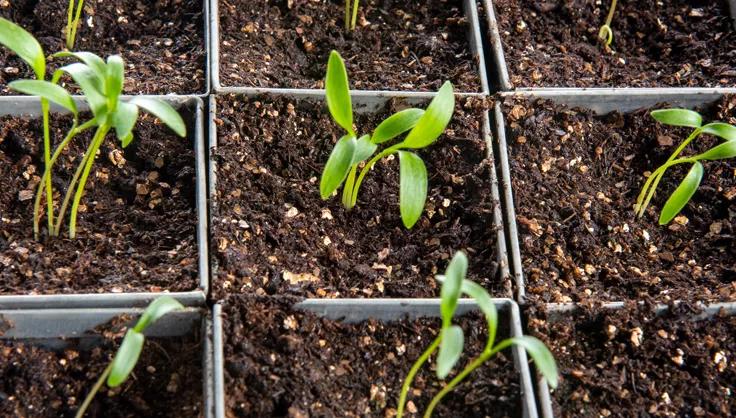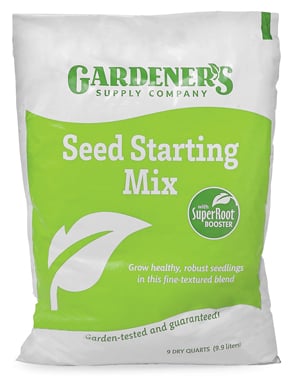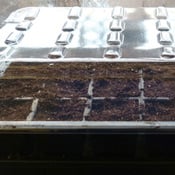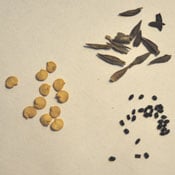How To Germinate Seeds
Plus, 3 easy ways to speed up your seeds!
 Germinate gorgeous seedlings in our Self-Watering Galvanized Seed Starting Tray.
Germinate gorgeous seedlings in our Self-Watering Galvanized Seed Starting Tray.What is seed germination?
Seeds are truly amazing little bundles. Packaged inside a sturdy outer coat, seeds contain all the reproductive material they'll ever need to grow into a basil plant, a hydrangea, an oak tree, and everything in between. Seed germination (also called "seed starting") is when a seed is woken from dormancy and begins to grow. Some seeds require very particular conditions (i.e., extended exposure to cold) to break out of its dormant state — this is referred to as "stratification". However most of our favorite annual flowers and veggies can be easily started indoors with just a few materials.
Why germinate seeds indoors?
- Give your garden a head start: For northern gardeners, there simply aren't enough days in the season to achieve fully mature plants — Zone 3 may only see 100 days of growing! Slow-growing, warm-season plants like tomatoes and melons simply won't have enough time to fruit before frost hits. Starting seeds indoors gives your plants a head start on the growing season.
- Better germination rates: By having control over light, moisture, and temperature, you can coddle your seeds with optimum growing conditions. You'll also avoid insect and animal pests that are more than willing to take down tiny seedlings.
- More variety: When purchasing a 6-pack of transplants, you are a bit at the mercy of whatever your local garden center happens to be carrying. Purchasing seeds allows you to choose from an infinite amount of colors, forms, flavors, and heirloom types.
What do I need to germinate seeds?
Most seeds are pretty low maintenance — after all, plants have been sprouting without human help for a looooooong time. But when we start seeds indoors, there are a few things we need to help things along:
Growing medium
Seeds need a lightweight, sterile seed growing medium. Garden soil from the backyard is far too compacted and, as thrifty as it sounds, don't try to reuse potentially diseased potting soil from one of your houseplants — start with fresh, sterile seed starting mix.
Once you've selected your growing medium, you'll need a container to house your seedlings while they grow. The best seed starting containers have drainage holes — overly soggy soil will spell disaster for seedlings. Alternatively, use a soil blocker to make an infinite number of (container-free!) seed starting cubes.
Moisture
Humidity is needed to jump-start seed germination — set a humidity dome on top of your seed starting containers to keep things moist.
However, once seeds have sprouted and a set of leaves has unfurled, remove the humidity dome so air can circulate between plants. Lack of air flow and overly damp leaves and stems are a recipe for damping off. After the humidity dome has been removed, water your seedlings from the bottom.
Light
Unless you are blessed with at least half a day of strong sunlight in your house, your seedlings will benefit greatly from a grow light. Choose a full spectrum (5,000-6,500 K) bulb — these will imitate natural sunlight and produce strong, sturdy seedlings. Not sure what "full spectrum" means? Read on and learn more about grow lights and lighting terminology.
Most seeds are planted at a depth of about 1-2 times their diameter — depending on the plant, seeds will be buried anywhere from 1/4 -inch to 2 inches below the surface. However some seeds require light to germinate (i.e., lettuce). For these, simply plant them on the surface of the growing medium and lightly press them in. Not all seeds need light to germinate (moisture and warmth will do) but once germinated, all seedlings need light.
Position your seedlings directly under the grow light. Weak, pale, “leggy” seedlings are often a sign that your plants are struggling to reach adequate light – move them closer! Seedlings require 14-16 hours of intense light per day; you may want to connect your grow light to a timer so plants get the correct amount of light and dark.
How long does it take for seeds to germinate?
| Plant | Days to Germinate Indoors | How Deep to Plant |
|---|---|---|
| Basil | 7-10 days | 1/4 inch |
| Broccoli | 7-10 days | 1/4 inch |
| Calendula | 7-14 days | 1/2 inch |
| Carrot | 7-21 days | 1/4 inch |
| Chive | 10-14 days | 1/4 inch |
| Cilantro | 7-10 days | 1/2 inch |
| Cucumber | 3-10 days | 1/2 inch deep |
| Dill | 10-14 days | Needs light to germinate; surface sow |
| Lettuce | 7-10 days | Needs light to germinate; surface sow |
| Marigold | 5-7 days | 1/8 inch |
| Melon | 3-7 days | 1/4 inch |
| Nasurtium | 7-14 days | 1 inch |
| Peas | 7-14 days | 1 inch |
| Pepper | 7-10 days | 1/4 inch |
| Snapdragon | 10-14 days | Needs light to germinate; surface sow |
| Spinach | 5-10 days | 1/2 inch |
| Squash, butternut | 7-10 days | 1 inch |
| Squash, summer | 7-10 days | 1/2 inch |
| Tomato | 5-10 days | 1/4 inch |
| Zinnia | 3-5 days | 1/4 inch |
3 Tips for Faster Seed Germination
1. Use a heat mat. Tucked under a grow light, enough warmth will be generated inside the humidity dome to germinate seeds. Some seeds do prefer extra toasty temps (like squash and cucumbers) and setting your seed starting containers on top of a heat mat will further warm things up. Take this tip with a grain of salt however, some cool-weather crops like sweet peas and spinach, will not germinate well at higher temperatures.
2. Soften the seed coat. Some seeds (morning glory, beans, and peas, for example) are known for having a super tough outer seed coat. Soak these seeds in warm water for 24 hours prior to planting.
3. Don't plant in the dry. Whatever growing medium you choose, be sure to gently moisten it prior to adding your seeds. Pour some in a large bucket and add a little water so the mix is consistently damp (not dripping!). If you plant your seeds in a dry mix and then try to overhead water, there’s a pretty good chance your tiny seeds will float away altogether!
Last updated: 01/17/2024
Print this Article:
Get the Dirt
Stay up to date on new articles and advice. Please fill out the information below.




